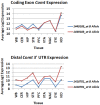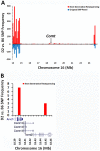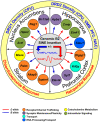A transposon in Comt generates mRNA variants and causes widespread expression and behavioral differences among mice
- PMID: 20808911
- PMCID: PMC2923157
- DOI: 10.1371/journal.pone.0012181
A transposon in Comt generates mRNA variants and causes widespread expression and behavioral differences among mice
Abstract
Background: Catechol-O-methyltransferase (COMT) is a key enzyme responsible for the degradation of dopamine and norepinephrine. COMT activity influences cognitive and emotional states in humans and aggression and drug responses in mice. This study identifies the key sequence variant that leads to differences in Comt mRNA and protein levels among mice, and that modulates synaptic function and pharmacological and behavioral traits.
Methodology/principal findings: We examined Comt expression in multiple tissues in over 100 diverse strains and several genetic crosses. Differences in expression map back to Comt and are generated by a 230 nt insertion of a B2 short interspersed element (B2 SINE) in the proximal 3' UTR of Comt in C57BL/6J. This transposon introduces a premature polyadenylation signal and creates a short 3' UTR isoform. The B2 SINE is shared by a subset of strains, including C57BL/6J, A/J, BALB/cByJ, and AKR/J, but is absent in others, including DBA/2J, FVB/NJ, SJL/J, and wild subspecies. The short isoform is associated with increased protein expression in prefrontal cortex and hippocampus relative to the longer ancestral isoform. The Comt variant causes downstream differences in the expression of genes involved in synaptic function, and also modulates phenotypes such as dopamine D1 and D2 receptor binding and pharmacological responses to haloperidol.
Conclusions/significance: We have precisely defined the B2 SINE as the source of variation in Comt and demonstrated that a transposon in a 3' UTR can alter mRNA isoform use and modulate behavior. The recent fixation of the variant in a subset of strains may have contributed to the rapid divergence of inbred strains.
Conflict of interest statement
Figures







References
-
- Karoum F, Chrapusta SJ, Egan MF. 3-Methoxytyramine is the major metabolite of released dopamine in the rat frontal cortex: reassessment of the effects of antipsychotics on the dynamics of dopamine release and metabolism in the frontal cortex, nucleus accumbens, and striatum by a simple two pool model. J Neurochem. 1994;63:972–979. - PubMed
-
- Huotari M, Gogos JA, Karayiorgou M, Koponen O, Forsberg M, et al. Brain catecholamine metabolism in catechol-O-methyltransferase (COMT)-deficient mice. Eur J Neurosci. 2002;15:246–256. - PubMed
Publication types
MeSH terms
Substances
Grants and funding
- P20 AA017828/AA/NIAAA NIH HHS/United States
- U01AA014425/AA/NIAAA NIH HHS/United States
- U01AA016667/AA/NIAAA NIH HHS/United States
- U01 AA013499/AA/NIAAA NIH HHS/United States
- U01AA13499/AA/NIAAA NIH HHS/United States
- U01 AA014425/AA/NIAAA NIH HHS/United States
- P20-DA 21131/DA/NIDA NIH HHS/United States
- U01 AA013513/AA/NIAAA NIH HHS/United States
- U01 AA016662/AA/NIAAA NIH HHS/United States
- U24AA13513/AA/NIAAA NIH HHS/United States
- R01 AA013678/AA/NIAAA NIH HHS/United States
- U01 AA016667/AA/NIAAA NIH HHS/United States
- P20 DA021131/DA/NIDA NIH HHS/United States
LinkOut - more resources
Full Text Sources
Molecular Biology Databases
Research Materials
Miscellaneous

